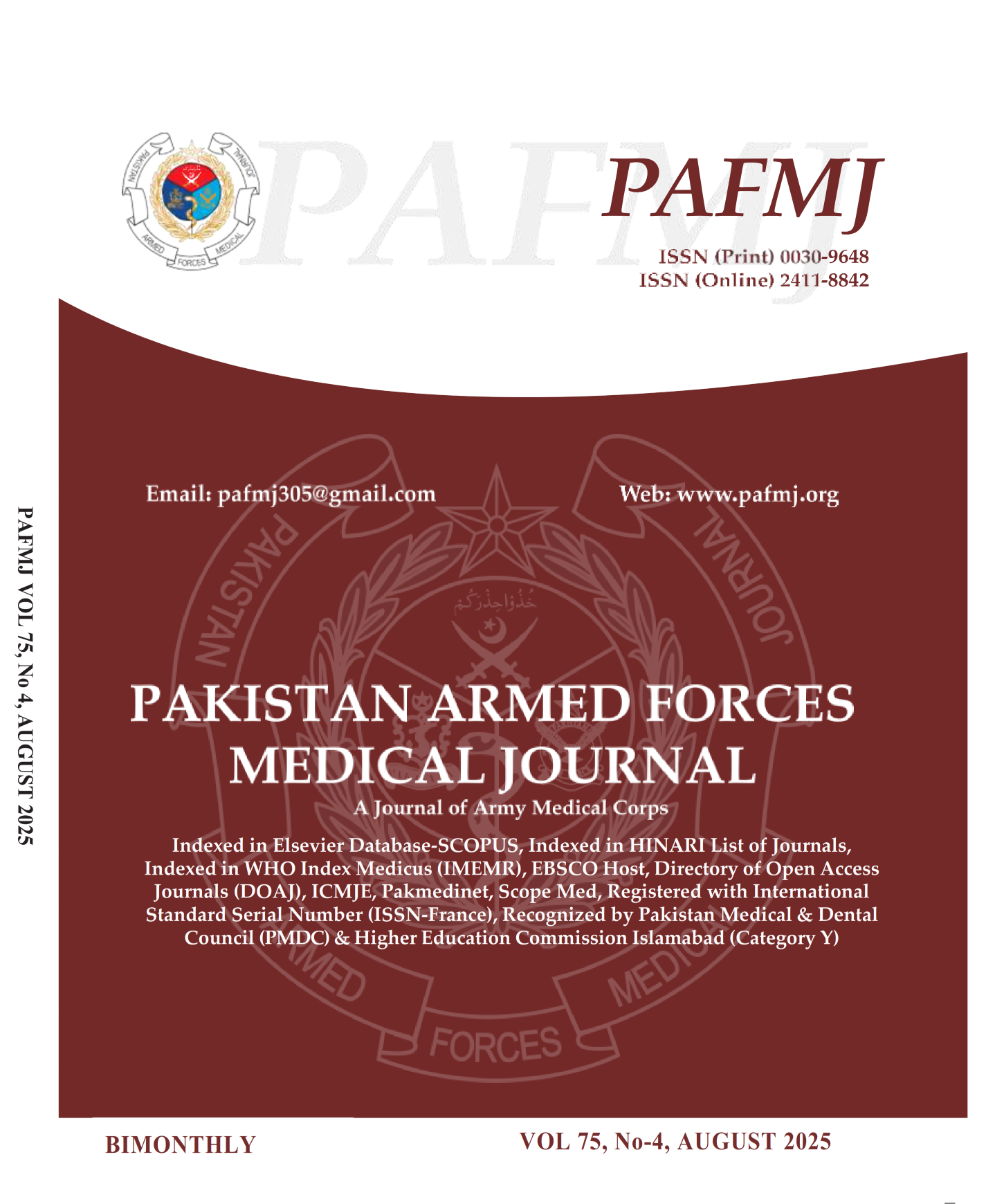Frequency and Distribution of Mount-Hume Classification Among Patients Requiring Root Canal Treatment at Armed Forces Institute of Dentistr
DOI:
https://doi.org/10.51253/pafmj.v75i4.13269Keywords:
Dental Caries, Endodontics, Root Canal Therapy, Tooth Loss.Abstract
Objective: To assess the frequency and distribution of Mount-Hume classification in patients requiring root canal treatment.
Study Design: Cross-sectional study.
Place and Duration of Study: Armed Forces Institute of Dentistry, Rawalpindi, Pakistan, from Jan 2024 to Jan 2025.
Methodology: Patients visiting operative department of AFID requiring root canal treatment were included in this study. Mount-Hume classification was used for categorizing patients depending upon the lesion site and size of it. Data including demographics, tooth type, lesion site, lesion size and etiology was recorded.
Results: A total of 280 teeth from 254 patients were endodontically treated with greater female (58.27%) compared to male (41.73%) patients. Caries was the predominant etiological factor presenting in 264(94.29%) cases. Molars were the most affected tooth type in 167(59.64%) cases, followed by 77(27.5%) premolars and 36(12.86%) anteriors. Significant associations between tooth type and etiology (p<0.001), tooth type and lesion site (p<0.001), and tooth type and size of lesion (p<0.001) were observed. While, site of lesion was found to be significantly associated with etiology (p<0.001), but not with lesion size (p=0.280)
Conclusion: Caries was the most common etiology behind root canal treatments, with molars predominantly affected tooth. Advanced diagnostic tools and preventive interventions are needed to mitigate the burden of carious lesions requiring root canal therapy.
Downloads
References
1. Huang G. Global trends in incidence of caries in permanent teeth of children aged 5 through 14 years, 1990 through 2019. J Am Dent Assoc 2024; 155(8): 667-678. e21.
http://doi.org/10.1016/j.adaj.2024.05.006
2. Medeiros TLM, Mutran SCAN, Espinosa DG, do Carmo-Freitas KF, Pinheiro HHC, D'Almeida Couto RS. Prevalence and risk indicators of non-carious cervical lesions in male footballers. BMC Oral Health 2020; 20(1): 215.
http://doi.org/10.1186/s12903-020-01200-9
3. Ismail AI, Sohn W, Tellez M, Amaya A, Sen A, Hasson H et al. The International Caries Detection and Assessment System (ICDAS): an integrated system for measuring dental caries. Community Dent Oral Epidemiol 2007; 35(3): 170-178.
http://doi.org/10.1111/j.1600-0528.2007.00347.x
4. Schwendicke F, Walsh T, Lamont T, Al-Yaseen W, Bjørndal L, Clarkson JE et al. Interventions for treating cavitated or dentine carious lesions. Cochrane Database Syst Rev 2021; 7(7): CD013039.
http://doi.org/10.1002/14651858.CD013039.pub2
5. Sá G, Braga MM, Junior JM, Ekstrand K, Ribeiro M, Bönecker M et al. The professional perception of the International Caries Classification and Management System (ICCMS): a pragmatic randomised clinical trial. Br Dental J 2025; 7510.
http://doi.org/10.1038/s41415-024-7510-9
6. Gugnani N, Pandit IK, Srivastava N, Gupta M, Sharma M. International Caries Detection and Assessment System (ICDAS): A New Concept. Int J Clin Pediatr Dent 2011; 4(2): 93-100.
http://doi.org/10.5005/jp-journals-10005-1089
7. Erkan D, Buedel SK, Soto-Rojas AE, Ungar PS, Eckert GJ, Stewart KT, et al. Objective characterization of dental occlusal and fissure morphologies: Method development and exploratory analysis. Arch Oral Biol 2023; 147: 105623.
http://doi.org/10.1016/j.archoralbio.2023.105623
8. Rathee M, Sapra A. Dental caries. In: StatPearls. Treasure Island (FL): StatPearls Publishing; 2023.
9. Budisak P, Brizuela M. Dental caries classification systems. In: StatPearls. Treasure Island (FL): StatPearls Publishing; 2023.
10. Youssefi MA, Afroughi S. Prevalence and Associated Factors of Dental Caries in Primary Schoolchildren: An Iranian Setting. Int J Dent 2020; 2020: 8731486.
http://doi.org/10.1155/2020/8731486
11. León-López M, Cabanillas-Balsera D, Martín-González J, Montero-Miralles P, Saúco-Márquez JJ, Segura-Egea JJ. Prevalence of root canal treatment worldwide: A systematic review and meta-analysis. Int Endod J 2022; 55(11): 1105-1127.
http://doi.org/10.1111/iej.13822
12. Paiva MAA, Mangueira Leite DFB, Farias IAP, Costa APC, Sampaio FC. Dental anatomical features and caries: A relationship to be investigated. In: Dental Anatomy. IntechOpen; 2017. https://doi.org/10.5772/intechopen.71337
13. Gkavela G, Pappa E, Rahiotis C, Mitrou P. Dietary habits and caries prevalence in older adults: A scoping review. Dietetics 2023; 3(3): 249-260. https://doi.org/10.3390/dietetics3030020
14. Olivieri JG, Elmsmari F, Miró Q, Ruiz X-F, Krell KV, García-Font M, et al. Outcome and survival of endodontically treated cracked posterior permanent teeth: A systematic review and meta-analysis. J Endod 2020; 46(4): 455–463.
https://doi.org/10.1016/j.joen.2020.01.006
15. Mukhaimer R, Hussein E, Orafi I. Prevalence of apical periodontitis and quality of root canal treatment in an adult Palestinian sub-population. Saudi Dent J 2012; 24: 149–155.
https://doi.org/10.1016/j.sdentj.2012.02.001
16. Sakulratchata R, Saelow D, Banyat S, Wongto S, Sappracha A, Kriangkrai R, et al., Progression of proximal caries in primary molars using the radiographic ICDAS: a retrospective cohort study. Eur Arch Paediatr Dent 2024; 25(3): 327-334.
https://doi.org/10.1007/s40368-024-00886-7
17. Khan SQ, Khabeer A, Al Harbi F, Arrejaie AS, Moheet IA, Farooqi FA et al. Frequency of root canal treatment among patients attending a teaching dental hospital in Dammam, Saudi Arabia. Saudi J Med Med Sci 2017; 5(2): 145–148.
https://doi.org/10.4103/1658-631X.204860
18. Teixeira DNR, Thomas RZ, Soares PV, Cune MS, Gresnigt MMM, Slot DE. Prevalence of noncarious cervical lesions among adults: A systematic review. J Dent 2020; 95: 103285.
https://doi.org/10.1016/j.jdent.2020.103285
19. Beg A, Altaf G, Garg S, Anand M. Clinical Study of Pit and Fissure Morphology and its Relationship with Caries Prevalence in Young Permanent First Molars. J South Asian Assoc Pediatric Dent 2019 2(2), 56–60.
Downloads
Published
License
Copyright (c) 2025 Talha Khurshid, Nadeem Ahmad Rana, Muzammil Hussain Shah, Hafiz Rabbi Ul Ehsan, Shan e Haider Naqvi, Ahmed Abdullah

This work is licensed under a Creative Commons Attribution-NonCommercial 4.0 International License.















